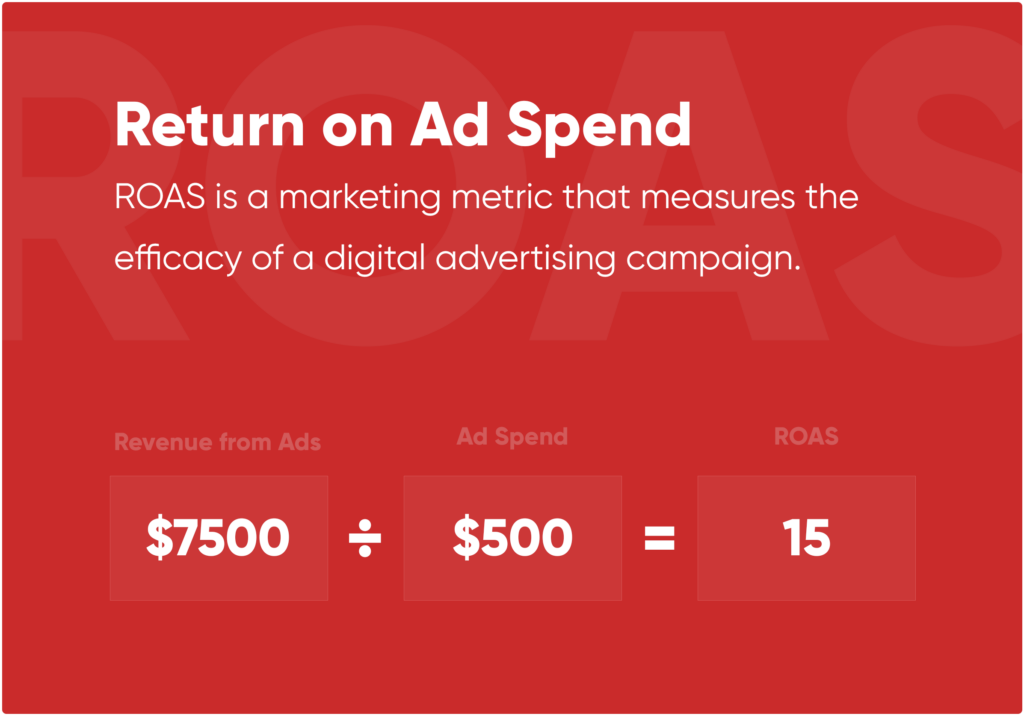Breakeven ROAS and its Importance for Your Business
After bouncing around tech start-ups and university literature programs, Joe has finally settled down as Billo’s Head of Content. Joe now spends his days writing ads about ads, teaching clients how to craft killer content, and combing through our web copy with a bold red Sharpie.

Knowing key performance indicators is essential for marketers and business owners. BreakEven Return On AdSpend or Breakeven ROAS is an essential KPI in e-commerce marketing.
This is important for one reason: it tells you exactly how much money your ad needs to make to cover the cost of the product/service that your ads are promoting.
You need to assess how profitable marketing is by considering additional costs such as salaries paid to marketers and agency fees paid to market companies to place ads.
What Is ROAS?
Return On AdSpend is a statistic that evaluates the amount of money generated for every dollar spent on a marketing campaign. Imagine making $ 5 for every $ 1 you spend on a marketing campaign.
This means that the ROAS of the campaign is 5 to 1. Ultimately, ad spending is used to assess the effectiveness of a single ad campaign, not the overall ROI.
In addition to ROAS, you may be tracking other metrics such as CTR and ROI.
Measuring different ROAS will give you a more accurate picture of your results. Of course, tracking metrics, conversion rate, and assessing success is an important part of marketing activities.

Difference Between ROAS and ROI
ROI evaluates the total return on investment, and advertising cost-effectiveness (ROAS) considers only the return on investment for a single ad campaign.
In essence, ROI is a comprehensive statistic, and ROAS stands for a specific metric that measures the performance of a single advertising campaign. Ultimately, this means that advertising costs are the only cost for ROAS calculation.
On the other hand, the ROI calculation considers the total cost of the project or campaign. The goal of the ads campaign is to increase the generated return on investment.
Use ROAS as an indicator to help you determine how you spend your advertising budget and how effective your efforts are.
The Importance of ROAS
When considering using sponsored ads to grow your e-commerce business economically, even marketing campaigns must first reach the break-even point.
From this point on, you expose your company to the opportunity to attract many new customers. That corresponds to a higher monthly net profit.
Using sponsored ads as part of your overall development strategy is a great idea, but you need to make sure it offers profitability. Otherwise, you run the risk of losing money.
There is no doubt that it will cost more than twice as much to sell sponsored ads compared to a marketplace where sales are down 12%.
This is why it’s critical to know all of your stats when creating all of your ad campaigns, so you can see what’s working and what isn’t.
Calculating ROAS/What Is a Good ROAS?
To calculate the ad spend ROAS, you need to use this simple formula: ads revenue/ads costs. From this ROAS calculation, you’ll generate a percentage that will help you see if your ad campaign is effective.
For example, if you generate $ 6 for every $ 1 you spend, your ROAS will be 6:1.
Gathering Data for Calculations
To calculate a ROAS may seem simple, but it can be difficult to get the data needed to complete the calculation. For example, you need to calculate the cost of ads, and it can get pretty tricky.
Factors to consider include advertising bid costs, labor costs to create creative assets, publisher fees, and affiliate fees.
However, to calculate ROAS, you need to accurately estimate the actual cost of your ad and other essential data.
Good ROAS
To determine your optimum between different ROAS, you need to know a good measure. ROAS range from $ 4 to $ 11 for every $ 1 spent on advertising, depending on the medium.
According to a recent survey, US advertisers generated about $ 11 per dollar spent on digital search advertising, making them media with high profitability (Google, for example).
Reduce your advertising budget, analyze your advertising campaigns and get a higher ROAS. We encourage you to tweak your landing site and rethink your negative keywords.
What Is a Break-even ROAS/How it Affects an Ad Campaign?

It is time to discuss the break-even return of money you spent on ads. We found a good B/E ROAS formula on QRY Blog. When we talk about the break-even point, we basically made as much money as we spent and made up for our losses.
For example, suppose you paid $ 50 for a Google ad set and received $ 50 for your income, so you have zero resources.
Therefore, break-even ROAS is a value that represents spent dollars on advertising and recovers costs from sales but is no longer profitable.
It’s important to note that break-even ROAS serves as a target ROAS for corporate advertising campaigns to maximize sales.
If the ROAS is well above the break-even ROAS, it means that you are not fully committed to raising brand awareness and reaching new consumers. This can affect the long-term growth of the campaigns and the overall advertising revenue.
The break-even point of return on investment (ROI) is a key indicator for your advertising campaigns to grow and your brand to become known to new consumers.
How to Calculate Breakeven Return on Ad Spend
To calculate, you should use the most efficient formula, which is as follows:
1/Gross Profit Margin = Breakeven Return on AdSpend.
There is a wide variety of break-even ROAS calculator options that include all viable data for calculating profits.
Calculating a Gross Profit Margin
If you do not want to use an online calculator, you can always calculate a gross profit margin by determining the average unit profit margin divided by the average unit retail price.
The formula?
(Average profit margin percentage) = (Average unit profit margin) / (Average profit margin percentage) (Average unit retail price).
An item sold for $50 that costs you $15 to produce will result in $35.
Is Breakeven Enough for Your Business?
There is no one-size-fits-all ROAS target. A positive ROAS in one market might be a disaster in another. The optimal ROAS target for you is determined by a complex web of variables such as your product costs, average order value, frequency, and price point.
This is a common metric for businesses whose clients buy from them multiple times a year but not regularly.
In these conditions, breaking even on new clients and promoting profit conversions on their second orders is a viable strategy.
For example, apparel manufacturers would aim for a break-even ROAS. On the other hand, if your firm sells things that are meant to be long-term investments, you’ll want a greater average order value and a high ROAS of over 100%.
Similarly, if your business is based on everyday goods sold through an online site, you can consider having a ROAS lower than 100%.
Using Break even ROAS to Improve Customer Lifetime Value and Boost Ad Campaigns
To understand one of the main advantages of having a break-even ROAS, you need to know CLV. Client lifetime value effectively assesses the worth a customer has to your brands over the course of your relationship, rather than on a purchase-by-purchase basis.
The CLV essentially specifies how much a client is worth to your company throughout their lifetime. Customer lifetime value is crucial, especially if you’re also tracking ROAS. It’s one thing to know how much money you’re spending on ads, and it’s another to know how much value each client you acquire as a result of those ads.
While your current ROAS accounts for sales made throughout the lifespan of an advertisement, it may be more difficult to monitor recurring transactions made by customers who saw that advertisement in the future.
Your ROAS should always be larger than your profit margin before advertising.
Make sure there is a large difference between the two indicators because if there is, your final profit margin should be significant. It may, however, be advantageous to incur a loss sometimes.
For example, when you can obtain a higher revenue, a minimum ROAS or break-even ROAS may be acceptable.
You might want to figure out a break-even return on Google ad campaigns that include CLV as well. CLV provides a more diverse background for ROAS and break-even ROAS.
This can be beneficial. Knowing more about CLV can help you understand actual customer acquisition costs and better understand the cost of goods sold. You will want to check out Billo by discussing the marketing strategies and selling your product with a customer.
It is software that will allow you to generate an interactive ad at an affordable pricing scheme. It offers conversions of regular videos to marketing beasts and stands as a beginner-friendly software that can skyrocket your brand.
Wrap Up
Someone in the industry may say that the break-even point ROAS means you can always outperform your competitors and minimize losses. It can also understand which markets to focus on to extend the reach and potentially increase average revenue.
It is no exaggeration to say that it is important to understand the break-even ROAS and adjust it according to the type of business for online marketing success. We have done our best to explain what CLV, ROAS, and break-even ROAS are. Now it’s up to you to harness that knowledge and double your revenue!
Looking to introduce ROAS to your UGC campaigns? Billo’s creative performance engine provides you with key data to optimize video ads based on important stats.
Continue learning:
Head of Content
After bouncing around tech start-ups and university literature programs, Joe has finally settled down as Billo’s Head of Content. Joe now spends his days writing ads about ads, teaching clients how to craft killer content, and combing through our web copy with a bold red Sharpie.

Authentic creator videos, powered by real performance data
22,000+ brands use Billo to turn UGC into high-ROAS video ads.
When to Trust Data-Driven Suggestions (and Whe...
Platforms, dashboards, and AI tools now shape nearly every marketing [...]...
Read full articleThe Power of Content Seeding: How to Plant Your ...
Content distribution has shifted — dramatically. Today, 70% of B2B [...]...
Read full article10 Common Digital Marketing Mistakes to Avoid in...
Digital marketing is fast, and what worked years ago might [...]...
Read full article



